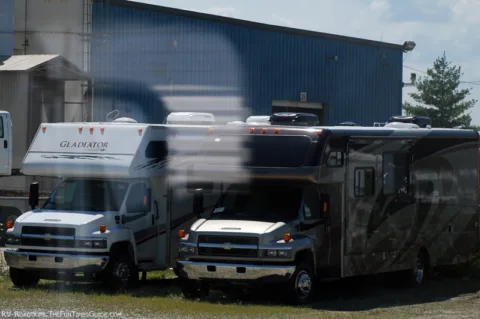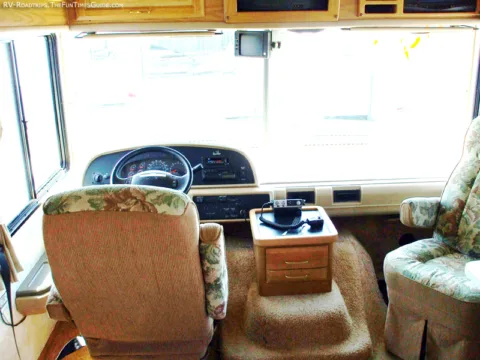Buying a used motorhome can be a bit scarier than the risks that come with buying a used travel trailer.
With a motorhome, you’re taking a much larger bite into your budget. Which is why it’s even more important that you know exactly what you’re getting when you’re looking for a used motorhome to buy.
With some 10-year-old motorhomes commanding upwards of $50,000 (or even more), being very selective is to your benefit.
Parked Motorhomes Decrease In Value
The one common denominator with most used recreational vehicles is that they spend a good deal of their time sitting still. Some will spend 10 to 11 months of the year in storage — only to come out for a few weeks in the middle of summer.
Because of their limited use, it’s not unusual to see many used RVs on the sales lot — often 10 or more years old with 20,000 or less miles on the odometer.
At first, this seems like a good thing for the potential buyer. When, in fact, this is both good and bad.
Obviously, wear on such things as engine internal components, brakes, transmission, and rear ends is minimal. Plus, motorhomes are more or less designed with a 100,000-mile lifetime expectation — so you should be good to go for many years to come.
But there is another factor that comes into play here: Time.
The worst thing for any piece of mechanical equipment is to leave it unused. It’s important that the inner workings get put through their paces on a fairly regular basis. That’s why leaving a motorhome parked and unused is one of the most damaging things you can do.
Location, Location, Location
The degree to which time has affected a particular motorhome depends greatly on where it spent that time while being parked.
For example, if you’re up north (like Minnesota) and your motorhome has spent most of its time buried in snow while parked in the yard, then your investment has already started to slip away.
What it all comes down to this this: More time parked and less time used will result in a motorhome being worth very little. That is, without costly repairs and upgrades to get the RV back up to speed.
Plus, parking a motorhome on grass (rather than on blacktop) results in moisture being wicked up into the rig, rusting it from the bottom up. Brakes will become stiff, frames will rot away, and floors will become spongy. After a few years in a row of being parked this way, the motorhome will pretty much be worthless.
If, on the other hand, the motorhome is parked for long periods of time down south (like Arizona), it will suffer from the effects of high heat and sun damage.
A motorhome that has been left out in the sun while stored will have a faded and chalky exterior. The interior upholstery will be sun bleached and brittle from the ultraviolet rays. Plastic will become brittle, and what was once white will now be a dull yellow color.
North, South, East, Or West?
What it all comes down to is this: Neither of the above situations is very appealing (high heat & massive sun -vs- freezing cold, snow & moisture).
But if I had my choice, I’d take a southern unit every time. You can remodel an interior with minimal skills. However, replacing a drivetrain takes special talents and a whole bunch of money.
The best approach is middle of the road…
Don’t be turned off by normal mileage — it usually means the motorhome has been driven appropriately and has been properly maintained. If the previous owners truly cared about their investment, the motorhome was kept under cover during periods of nonuse, and it was probably taken out and driven now and then to keep it in good operating condition.
This will show in the overall condition of the motorhome.
What To Look For In A Used Motorhome
Here are a few things you should look at when you’re exploring used motorhomes to buy:
- Are the colors bright and crisp?
- Is the interior clean?
- Are the fabrics soft and pliable?
- When you crawl underneath the motorhome, is the frame still black, the color it was from the factory? Minor rust discoloration is okay, but a thick coating of brown oxidation (rust) is a sign of improper storage.
- When you first start the motorhome, do you see a small cloud of blue smoke that clears away quickly? This is an indication of leaking valve guide seals and excessive oil consumption. A sign that rubber gaskets have hardened due to lack of use and Father Time.
- Look for signs of leakage at the seam between the engine and transmission. Any sign of red indicates a transmission front seal leak. The only way to cure any leaking seal is to disassemble and replace it. Forget additives; this is a serious investment. Running out of transmission fluid between here and there will cost you a fortune. Never do a temporary fix, except in an emergency.
- With the level of financial risk involved, I wouldn’t be bashful about having a compression test done to the engine. As long as all cylinders are about equal, you’re probably in good shape.
Of course the same issues you would find in an RV travel trailer still apply here, as well. Run the slide outs all the way out, check all appliances for proper operation. Hook up a water hose, and pressurize the water system.
Finally, be sure the price tag is in line with the condition of the motorhome. Even fixer-uppers need to be sold. And fixer-uppers can be a smart investment, as long as the price matches the condition of the vehicle.
Remember, you’re in the drivers seat. Recognize those things that are deal breakers, and don’t be afraid to point them out to the owner of the motorhome. There are gazillions of used motorhomes available. Who knows?… The best used motorhome might be the next one you see. Then again, you may not find it until you’ve looked here, there, and everywhere in between.
Much like buying a house, the process of buying a motorhome can be time-consuming. But it’s in your best interest to do your homework. Take good notes. And compare the pro’s and con’s of each motorhome that you’re interested in.
Must read: The Ultimate Used RV Buyer’s Checklist





